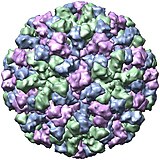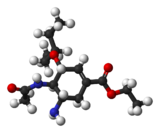
Back بوابة:علم الفيروسات Arabic درگاه:ویروس Persian Portail:Virologie French Portal:Virus ID Portal:Vírus Portuguese ද්වාරය:වෛරස Singhalese باب:وائرسز Urdu Portal:病毒 Chinese
The Viruses Portal
Welcome!

Viruses are small infectious agents that can replicate only inside the living cells of an organism. Viruses infect all forms of life, including animals, plants, fungi, bacteria and archaea. They are found in almost every ecosystem on Earth and are the most abundant type of biological entity, with millions of different types, although only about 6,000 viruses have been described in detail. Some viruses cause disease in humans, and others are responsible for economically important diseases of livestock and crops.
Virus particles (known as virions) consist of genetic material, which can be either DNA or RNA, wrapped in a protein coat called the capsid; some viruses also have an outer lipid envelope. The capsid can take simple helical or icosahedral forms, or more complex structures. The average virus is about 1/100 the size of the average bacterium, and most are too small to be seen directly with an optical microscope.
The origins of viruses are unclear: some may have evolved from plasmids, others from bacteria. Viruses are sometimes considered to be a life form, because they carry genetic material, reproduce and evolve through natural selection. However they lack key characteristics (such as cell structure) that are generally considered necessary to count as life. Because they possess some but not all such qualities, viruses have been described as "organisms at the edge of life".
Selected disease
Yellow fever is an acute haemorrhagic fever caused by the yellow fever virus, an RNA virus in the Flaviviridae family. It infects humans, other primates, and Aedes aegypti and other mosquito species, which act as the vector. After transmission by the bite of a female mosquito, the virus replicates in lymph nodes, infecting dendritic cells, and can then spread to liver hepatocytes. Symptoms generally last 3–4 days, and include fever, nausea and muscle pain. In around 15% of people, a toxic phase follows with recurring fever, liver damage and jaundice, sometimes accompanied by bleeding and kidney failure; death occurs in 20–50% of those who develop jaundice. Infection otherwise leads to lifelong immunity.
The first definitive outbreak of yellow fever was in Barbados in 1647, and major epidemics have occurred in the Americas and southern Europe since that date. Yellow fever is endemic in tropical and subtropical areas of South America and Africa; its incidence has been increasing since the 1980s. An estimated 200,000 cases and 30,000 deaths occur each year, with almost 90% of cases being in Africa. Antiviral therapy is not effective. A vaccine is available, and vaccination, mosquito control and bite prevention are the main preventive measures.
Selected image
1802 cartoon of Edward Jenner administering cowpox vaccine against smallpox, satirising contemporary fears about vaccination.
Credit: James Gillray (12 June 1802)
In the news
26 February: In the ongoing pandemic of severe acute respiratory syndrome coronavirus 2 (SARS-CoV-2), more than 110 million confirmed cases, including 2.5 million deaths, have been documented globally since the outbreak began in December 2019. WHO
18 February: Seven asymptomatic cases of avian influenza A subtype H5N8, the first documented H5N8 cases in humans, are reported in Astrakhan Oblast, Russia, after more than 100,0000 hens died on a poultry farm in December. WHO
14 February: Seven cases of Ebola virus disease are reported in Gouécké, south-east Guinea. WHO
7 February: A case of Ebola virus disease is detected in North Kivu Province of the Democratic Republic of the Congo. WHO
4 February: An outbreak of Rift Valley fever is ongoing in Kenya, with 32 human cases, including 11 deaths, since the outbreak started in November. WHO
21 November: The US Food and Drug Administration (FDA) gives emergency-use authorisation to casirivimab/imdevimab, a combination monoclonal antibody (mAb) therapy for non-hospitalised people twelve years and over with mild-to-moderate COVID-19, after granting emergency-use authorisation to the single mAb bamlanivimab earlier in the month. FDA 1, 2
18 November: The outbreak of Ebola virus disease in Équateur Province, Democratic Republic of the Congo, which started in June, has been declared over; a total of 130 cases were recorded, with 55 deaths. UN
Selected article
Bats host a diverse array of viruses, including all seven types described by the Baltimore classification system. The most common viruses known to infect bats are coronaviruses. Bats harbour many viruses that are zoonotic, or capable of infecting humans, including rabies virus, SARS-CoV, SARS-CoV-2, MERS-CoV, Nipah virus, Hendra virus and Marburg virus (hosted by the Egyptian fruit bat; pictured), and some bat-borne viruses are considered important emerging viruses. Bats may also play a role in the ecology of the Ebola virus. Most zoonotic bat viruses are transmitted by direct contact with infected bat fluids such as urine, guano and saliva, or through contact with an infected intermediate host; transmission of rabies from bats to humans usually occurs via biting. Butchering or consuming bat meat could potentially lead to viral transmission.
Bats rarely become ill from viral infections, and rabies is the only viral disease known to kill them. They might be more tolerant of infection than other mammals. Their immune systems differ from those of other mammals in their lack of several inflammasomes, which activate the body's inflammatory response, as well as a dampened stimulator of interferon genes response, which helps to control the host response to pathogens.
Selected outbreak
The West African Ebola epidemic was the most widespread outbreak of the disease to date. Beginning in Meliandou in southern Guinea in December 2013, it spread to adjacent Liberia and Sierra Leone, affecting the cities of Conakry and Monrovia, with minor outbreaks in Mali and Nigeria. Cases reached a peak in October 2014 and the epidemic was under control by late 2015, although occasional cases continued to occur into April 2016. Ring vaccination with the then-experimental vaccine rVSV-ZEBOV was trialled in Guinea.
More than 28,000 suspected cases were reported with more than 11,000 deaths; the case fatality rate was around 40% overall and around 58% in hospitalised patients. Early in the epidemic nearly 10% of the dead were healthcare workers. The outbreak left about 17,000 survivors, many of whom reported long-lasting post-recovery symptoms. Extreme poverty, dysfunctional healthcare systems, distrust of government after years of armed conflict, local burial customs of washing the body, the unprecedented spread of Ebola to densely populated cities, and the delay in response of several months all contributed to the failure to control the epidemic.
Selected quotation
| “ | What is needed ... is a new inquiry at international level ... to investigate a reconciliation between the right to health and the right of authors to proper protection for their inventions. At the moment, all the eggs are in the basket of the authors, and it’s not really a proportionate balance. | ” |
—Michael Kirby on the cost of antiviral drugs
Recommended articles
Viruses & Subviral agents: bat virome • elephant endotheliotropic herpesvirus • HIV • introduction to viruses![]() • Playa de Oro virus • poliovirus • prion • rotavirus
• Playa de Oro virus • poliovirus • prion • rotavirus![]() • virus
• virus![]()
Diseases: colony collapse disorder • common cold • croup • dengue fever![]() • gastroenteritis • Guillain–Barré syndrome • hepatitis B • hepatitis C • hepatitis E • herpes simplex • HIV/AIDS • influenza
• gastroenteritis • Guillain–Barré syndrome • hepatitis B • hepatitis C • hepatitis E • herpes simplex • HIV/AIDS • influenza![]() • meningitis
• meningitis![]() • myxomatosis • polio
• myxomatosis • polio![]() • pneumonia • shingles • smallpox
• pneumonia • shingles • smallpox
Epidemiology & Interventions: 2007 Bernard Matthews H5N1 outbreak • Coalition for Epidemic Preparedness Innovations • Disease X • 2009 flu pandemic • HIV/AIDS in Malawi • polio vaccine • Spanish flu • West African Ebola virus epidemic
Virus–Host interactions: antibody • host • immune system![]() • parasitism • RNA interference
• parasitism • RNA interference![]()
Methodology: metagenomics
Social & Media: And the Band Played On • Contagion • "Flu Season" • Frank's Cock![]() • Race Against Time: Searching for Hope in AIDS-Ravaged Africa
• Race Against Time: Searching for Hope in AIDS-Ravaged Africa![]() • social history of viruses
• social history of viruses![]() • "Steve Burdick" • "The Time Is Now" • "What Lies Below"
• "Steve Burdick" • "The Time Is Now" • "What Lies Below"
People: Brownie Mary • Macfarlane Burnet![]() • Bobbi Campbell • Aniru Conteh • people with hepatitis C
• Bobbi Campbell • Aniru Conteh • people with hepatitis C![]() • HIV-positive people
• HIV-positive people![]() • Bette Korber • Henrietta Lacks • Linda Laubenstein • Barbara McClintock
• Bette Korber • Henrietta Lacks • Linda Laubenstein • Barbara McClintock![]() • poliomyelitis survivors
• poliomyelitis survivors![]() • Joseph Sonnabend • Eli Todd • Ryan White
• Joseph Sonnabend • Eli Todd • Ryan White![]()
Selected virus
Noroviruses are a genus of non-enveloped, single-stranded RNA viruses in the family Caliciviridae. The positive-sense RNA genome is approximately 7500 nucleotides long. Known noroviruses fall into five different genogroups (GI–GV); three groups infect humans, the other two mice, and cattle and other bovines. All are considered strains of a single species, Norwalk virus.
Noroviruses are extremely contagious, with fewer than 20 virus particles being infectious. They are transmitted directly from person to person and indirectly via contaminated water and food. After infection, the virus replicates in the small intestine, causing acute gastroenteritis, which develops 12–48 hours after exposure and lasts for 24–72 hours. The characteristic symptoms include nausea, forceful vomiting, watery diarrhoea and abdominal pain. Infection is usually self-limiting and rarely severe. Noroviruses cause 18% of acute gastroenteritis episodes in humans, with around 685 million cases and 200,000 deaths every year, mainly in very young, elderly or immunosuppressed people. No vaccine is available. Hand washing with soap and water is effective in reducing transmission.
Did you know?
- ...that infectious disease specialist Daniel R. Lucey has hypothesised that the SARS-CoV-2 virus (pictured) responsible for the 2019–20 coronavirus outbreak may have been quietly circulating among humans since at least November 2019?
- ...that the Kunjin virus, which can be transmitted by mosquitoes and may cause encephalitis in humans, is named for an Indigenous Australian clan living near where the virus was first isolated?
- ...that the Vaccine Confidence Project was developed in response to a boycott of polio eradication efforts in Nigeria?
- ...that the Gaussian network model has a wide range of applications from enzymes composed of a single domain, to large macromolecular assemblies, such as ribosomes and viral capsids?
- ...that Trinidadian virologist Joseph Lennox Pawan was the first person to show that rabies could be spread by vampire bats to other animals and humans?
Selected biography
Frederick Sanger (13 August 1918 – 19 November 2013) was a British biochemist, the only person to have been awarded the Nobel Prize for Chemistry twice.
He started to research nucleic acid sequencing in the early 1960s. In 1975, he co-invented the "Plus and Minus" technique for sequencing DNA, which could sequence 80 nucleotides at once, a significant improvement on earlier techniques. Using this method, his group sequenced most of the 5,386 nucleotides of φX174 bacteriophage – the first virus and the first DNA genome to be completely sequenced – and showed that some of its genes overlapped. In 1977, he and his group pioneered the Sanger (or dideoxy chain-termination) method for sequencing DNA and used it to sequence the 48,502 bp bacteriophage λ. His technique remained the most widely used sequencing method until the mid-2000s, and was used to generate the first human genome sequence. Sanger is also known for sequencing bovine insulin, the first protein to be sequenced. The Sanger Institute was named for him.
In this month
1 July 1796: Edward Jenner first challenged James Phipps with variolation, showing that cowpox inoculation is protective against smallpox
3 July 1980: Structure of southern bean mosaic virus solved by Michael Rossmann and colleagues
6 July 1885: Louis Pasteur (pictured) gave rabies vaccine to Joseph Meister
10 July 1797: Jenner submitted paper on Phipps and other cases to the Royal Society; it was read to the society but not published
14–20 July 1968: First International Congress for Virology held in Helsinki
16 July 2012: FDA approved tenofovir/emtricitabine (Truvada) for prophylactic use against HIV; first prophylactic antiretroviral
19 July 2013: Pandoravirus described, with a genome twice as large as Megavirus
22 July 1966: International Committee on Nomenclature of Viruses (later the ICTV) founded
25 July 1985: Film star Rock Hudson made his AIDS diagnosis public, increasing public awareness of the disease
28 July 2010: First global World Hepatitis Day
Selected intervention
Oseltamivir (also Tamiflu) is an oral antiviral drug against influenza (flu). It was the second inhibitor of the viral neuraminidase to be developed, after zanamivir, and the first to be taken as an oral tablet. It was originally synthesised from shikimic acid extracted from the star anise plant. Oseltamivir is a prodrug that requires metabolism in the liver to the active form, oseltamivir carboxylate. This binds at the active site of the neuraminidase enzyme, preventing it from cleaving sialic acid to release the virus particle from the host cell. Oseltamivir can reduce the duration of influenza symptoms by 0.5–1 days. Debate is ongoing about whether it also reduces the risk of complications, such as pneumonia. Nausea and vomiting are the main adverse events. Resistance to oseltamivir has been observed in some strains of influenza virus, especially H1N1 strains.
Subcategories
Subcategories of virology:
Topics
Things to do
- Comment on what you like and dislike about this portal
- Join the Viruses WikiProject
- Tag articles on viruses and virology with the project banner by adding {{WikiProject Viruses}} to the talk page
- Assess unassessed articles against the project standards
- Create requested pages: red-linked viruses | red-linked virus genera
- Expand a virus stub into a full article, adding images, citations, references and taxoboxes, following the project guidelines
- Create a new article (or expand an old one 5-fold) and nominate it for the main page Did You Know? section
- Improve a B-class article and nominate it for Good Article
 or Featured Article
or Featured Article status
status - Suggest articles, pictures, interesting facts, events and news to be featured here on the portal
WikiProjects & Portals
 WikiProject Viruses
Related WikiProjects
WikiProject Viruses
Related WikiProjects
Medicine • Microbiology • Molecular & Cellular Biology • Veterinary Medicine
Related PortalsAssociated Wikimedia
The following Wikimedia Foundation sister projects provide more on this subject:
-
Commons
Free media repository -
Wikibooks
Free textbooks and manuals -
Wikidata
Free knowledge base -
Wikinews
Free-content news -
Wikiquote
Collection of quotations -
Wikisource
Free-content library -
Wikispecies
Directory of species -
Wikiversity
Free learning tools -
Wiktionary
Dictionary and thesaurus


















